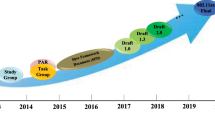Abstract
High-dense deployment scenario is supposed to be the killer scenario of the future wireless networks. The next generation high efficiency wireless local area networks (WLANs) standard - IEEE 802.11ax, which will be released in the year 2019, directly faces to the high-dense deployment scenario. IEEE 802.11ax is one milestone of WLAN standardization. Thus, a series of media access control technologies are introduced in IEEE 802.11ax such as multi-user MAC (MU-MAC) enhancements, spatial reuse (SR) technology, and target wake-up time (TWT) based power saving mechanism. This paper comprehensively surveys the key technologies proposes a tutorial for IEEE 802.11ax. Some valuable insights are presented in this paper. To the best of our knowledge, this is the first work to directly investigate and analyze the latest stable version (Draft 4.0) of IEEE 802.11ax.















Similar content being viewed by others
References
Al-Fuqaha A, Guizani M, Mohammadi M, Aledhari M, Ayyash M (2015) Internet of things: A survey on enabling technologies, protocols, and applications. IEEE Communications Surveys Tutorials 17(4):2347–2376. Fourthquarter
Kamel M, Hamouda W, Youssef A (2016) Ultra-dense networks: A survey. IEEE Communications Surveys Tutorials 18(4):2522–2545. Fourthquarter
Wireless lan (2019) medium access control (mac) and physical layer (phy) specifications amendment 6: Enhancements for high efficiency wlan. IEEE Draft 802.11ax/D4.0
collab=IEEE. 802.11 hew sg proposed par. doc (2014) IEEE 802.11-14/0165R1 IEEE
Deng DJ, Chen KC, Cheng RS (2014) Ieee 802.11ax: Next generation wireless local area networks. In: 10th International Conference on Heterogeneous Networking for Quality, Reliability Security and Robustness, pp 77–82
Li B, Qu Q, Yan Z, Yang M (2015) Survey on ofdma based mac protocols for the next generation wlan. In: 2015 IEEE Wireless Communications and Networking Conference Workshops (WCNCW), pp 131–135
Khorov E, Kiryanov A, Lyakhov A (2015) Ieee 802.11ax: How to build high efficiency wlans. In: In 2015 International Conference on Engineering and Telecommunication (EnT), pp 14–19
Bellalta B, Bononi L, Bruno R, Kassler A (2016) Next generation ieee 802.11 wireless local area networks: Current status, future directions and open challenges. Computer Communications 75:1–25. Supplement C
Cheng N, Xuemin (Sherman) S (2017) Next-generation High-Efficiency WLAN. 5G Mobile Communications 651–675
Gong MX, Hart B, Mao S (2015) Advanced wireless lan technologies: Ieee 802.11ac and beyond. GetMobile:, Mobile Comp. and Comm. 18(4):48–52
Deng DJ, Lien SY, Lee J, Chen KC (2016) On quality-of-service provisioning in ieee 802.11ax wlans. IEEE Access 4:6086–6104
Afaqui MS, Garcia-Villegas E, Lopez-Aguilera E (2017) Ieee 802.11ax: Challenges and requirements for future high efficiency wifi. IEEE Wirel Commun 24(3):130–137
Omar HA, Abboud K, Cheng N, Malekshan KR, Gamage AT, Zhuang W (2016) A survey on high efficiency wireless local area networks: Next generation wifi. IEEE Communications Surveys Tutorials 18(4):2315–2344. Fourthquarter
Bellalta B (2016) Ieee 802.11ax: High-efficiency wlans. IEEE Wirel Commun 23(1):38–46
Au K, Zhang L, Nikopour H, Yi E, Bayesteh A, Vilaipornsawai U, Ma J, Zhu P (2014) Uplink contention based scma for 5g radio access. In: 2014 IEEE Globecom Workshops (GC Wkshps), pp 900–905
Bayesteh A, Yi E, Nikopour H, Baligh H (2014) Blind detection of scma for uplink grant-free multiple-access. In: 2014 11th International Symposium on Wireless Communications Systems (ISWCS), pp 853–857
Dai L, Wang B, Yuan Y, Han S, I C. l., Wang Z (2015) Non-orthogonal multiple access for 5g: solutions, challenges, opportunities, and future research trends. IEEE Communications Magazine 53 (9):74–81
Acknowledgements
This work was supported in part by the National Natural Science Foundations of CHINA (Grant No. 61771390, No. 61501373, No. 61771392, and No. 61271279), the National Science and Technology Major Project (Grant No. 2016ZX03001018-004), and the Fundamental Research Funds for the Central Universities (Grant No. 3102017ZY018).
Author information
Authors and Affiliations
Corresponding author
Additional information
Publisher’s Note
Springer Nature remains neutral with regard to jurisdictional claims in published maps and institutional affiliations.
Rights and permissions
About this article
Cite this article
Yang, M., Li, B. & Yan, Z. MAC Technology of IEEE 802.11ax: Progress and Tutorial. Mobile Netw Appl 26, 1122–1136 (2021). https://doi.org/10.1007/s11036-020-01622-3
Published:
Issue Date:
DOI: https://doi.org/10.1007/s11036-020-01622-3




